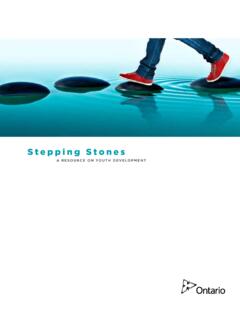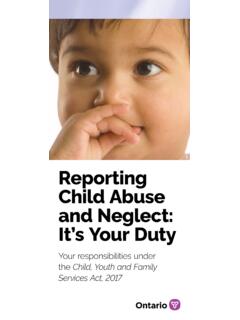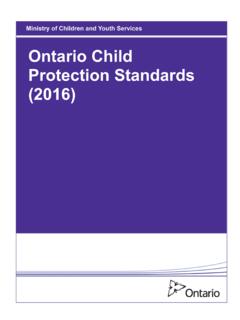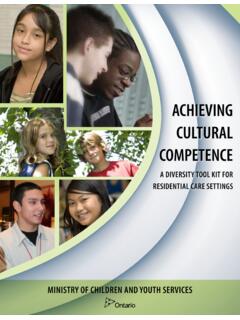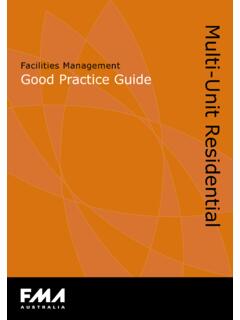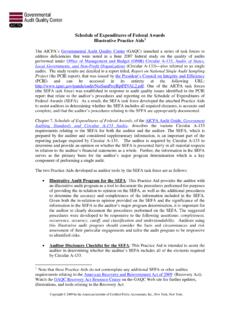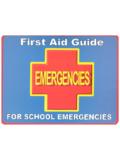Transcription of Customary Care Guide - Ontario
1 formal Customary care A Practice Guide to Principles, Processes and Best practices In accordance with the Ontario Permanency Funding Policy Guidelines (2006) and the Child and Family Services Act 2 formal Customary care * A Practice Guide to Principles, Processes and Best practices *In accordance with the Ontario Permanency Funding Policy Guidelines (2006) and the Child and Family Services Act 3 Table of Contents formal Customary care Practice Guide Project Team .. 6 Disclaimers .. 6 Artwork .. 6 Acknowledgments .. 7 Preamble .. 9 Success Indicator .. 9 Scope of the Guide .. 9 Clarification of Terms Used in this Practice Guide .. 10 Acronyms Used in this Practice Guide .. 13 PART A: UNDERSTANDING formal Customary care .. 14 Background .. 14 The Child and Family Services Act (CFSA) .. 15 2010 Review of the Child and Family Services 16 Tripartite Technical Table on Child Welfare.
2 17 Methodology .. 17 Understanding Customary care .. 18 Why Use formal Customary care ? .. 20 Community and Cultural Linkages .. 21 Lifelong Healing .. 21 Dispelling Myths .. 23 PART B: USING formal Customary care STEP BY STEP .. 28 Using formal Customary care Step by Step Flow Chart .. Error! Bookmark not defined. First-Time Contact with a First Nation Child Requiring Placement .. 30 Notification to Representative of the First Nation .. 32 Consultation Under the 33 Customary care Declaration by a First Nation .. 34 Assessment of the Proposed Place of Safety .. 34 Attestation of the First Nation .. 36 Jurisdictional Considerations .. 36 Opportunities for Changing CAS Practice .. 37 The Judiciary .. 38 Office of the Children s Lawyer (OCL) .. 38 4 Challenges and Solutions .. 39 Alternative Dispute Resolution .. 39 Protocols .. 39 Recruiting First Nation-Based formal Customary care Homes.
3 41 Liability and 42 Summary: This is What We .. 43 Next Steps .. 44 Frequently Asked Questions .. 45 Resources .. 48 References .. 50 APPENDICES .. 54 Appendix A .. 54 Designated Aboriginal Child and Family Services Agencies in Ontario .. 54 Aboriginal Child and Family Services Agencies in Ontario .. 56 Appendix B .. 58 Band Council Resolution (sample) .. 58 Customary care Declaration (sample) .. 59 Appendix C .. 60 Sample Customary care Agreement .. 60 Appendix D .. 65 Sample Protocol Between CAS and First Nation .. 65 Appendix E .. 78 Sample Letter of Notification to a First 78 Appendix F .. 79 Ontario Permanency Funding Policy Guidelines for formal Customary care .. 79 Appendix G .. 80 Customary care Art Gallery .. 80 5 6 formal Customary care Practice Guide Project Team Deb Cantrell, , Project Lead Marion Roberts, MSW, Project Consultant David Barnes, MSW, Project Consultant Disclaimers Nothing in this document should be construed as legal advice.
4 Readers are advised to obtain independent legal counsel when necessary. This document is a resource only and does not have the force and effect of ministry legislation, regulations or policies. References concerning specific policies and legislation are current as of the publication date and are subject to change. References to resource and reference materials, Internet sites and organizations are included for information only. The Ministry of Children and Youth Services (MCYS) and the Ministry of Community and Social Services (MCSS) are not responsible for the quality of the content on non-ministry Internet sites or for ensuring that the content of the material on non-ministry Internet sites listed is up to date. The linked websites may not be available in French, unless otherwise stated. Artwork The artwork that appears on the cover and in the Art Gallery (see Appendix G) was submitted by First Nation youth between the ages of 12 and 16 as part of a contest in which youth were invited to create artwork reflecting the theme, "This is what Customary care means to me.
5 Entry information was sent to both Aboriginal children s aid societies and Aboriginal Child and Family Services Agencies in Ontario . The submissions were rated by members of the formal Customary care Practice Guide Project Steering Committee. Cover Page and winner of first prize: July, age 14, Wahgoshig First Nation Winner of second prize: Alishia, age 13, Wahgoshig First Nation Winner of third prize: Emily, age 14, Oneida First Nation Honorable Mentions were awarded to the following youth: Desire, age 13, Wahgoshig First Nation Farah, age 10, Wahgoshig First Nation Caitlyn, age 13, Wahgoshig First Nation Chassity, age 12, Wahgoshig First Nation Warren, age 13, Eabametoong First Nation 7 Merlin, age 13, Pikangikum First Nation Cheyenne, age 14, Serpent River First Nation Kira, age 14, Wikwemikong First Nation Acknowledgments Barnes Management Group (now Lough Barnes Consulting Group (LBCG)) is honoured to have been selected to manage the developmental process that culminated in this Practice Guide .
6 We gratefully acknowledge the contributions of numerous individuals and groups whose wisdom, experience and forthrightness have made this resource a reality. The content of this Practice Guide has been informed by consultations and interviews with hundreds of cross-sector practitioners from every region of the province. We sincerely appreciate the questions raised and suggestions made by representatives from the following groups: Child welfare professionals from Aboriginal and non-Aboriginal children s aid societies; Family support, resource and prevention workers from Aboriginal child and family services organizations; Lawyers representing children s aid societies; Lawyers representing First Nation children and families; Representatives from First Nations (more commonly known as Band Reps ); Chiefs and Council members; Elders and other natural helpers; Ontario Office of the Children s Lawyer; and Family Court Judiciary.
7 We extend a generous thank you to our second level Readers who read the second draft of the Practice Guide , and provided thoughtful feedback and suggestions, many of which were incorporated in subsequent drafts. Readers include: Luanne Povey, Supervisor of Family Services, Garden River First Nation Crystal Doolittle, Supervisor, Aboriginal Services, The Children s Aid Society of Simcoe County Kristian Wilson, Supervisor, Native Services Unit, The Children s Aid Society of London and Middlesex Evelyn Hendrick, Customary care Coordinator, Mnaasged Child and Family Services Brandi Hildebrand, Family Services Supervisor, Tyendinaga Mohawk Family Services, Tyendinaga First Nation Marianne Borg, Child Advocate, Office of the Provincial Advocate for Children and Youth Melanie Mahler, Supervisor, Aboriginal Unit, The Children s Aid Society of Algoma Special thanks are extended to Kevin Morris, a retired senior policy analyst (MCYS), for sharing his extensive knowledge and providing valuable feedback on every draft.
8 8 We are deeply grateful for the invaluable and enduring contributions of the members of the Project Steering Committee, a diverse and committed group of individuals, who came together almost monthly to share their wisdom, provide valuable feedback, and to lend their support at every juncture of the developmental process. While the Practice Guide does not necessarily reflect the views of all Project Steering Committee members, their feedback and suggestions were carefully considered. Members of the Project Steering Committee: Kenn Richard, Native Child and Family Services of Toronto Ernest Beck, Tikinagan Child and Family Services Jim Baraniuk, Children s Aid Society of Algoma Colette Prevost, Children s Aid Society of the Districts of Sudbury and Manitoulin Andy Koster, Children s Aid Society of Brant Stan Cloud, Chiefs of Ontario Social Services Coordination Unit Adrienne Pelletier, Chiefs of Ontario Social Services Coordination Unit Jerry Goldhar, Legal Counsel (retired) Karen Hill, Ontario Association of Children s Aid Societies Finally, the development of this Guide would not have been possible without the commitment and unwavering support of Esther Levy and Peter Kiatipis, representing the Ministry of Children and Youth Services, Child Welfare Secretariat and serving as observers at the Customary care Practice Guide Project Steering Committee meetings.
9 It has been our privilege to work with the above individuals in developing this Practice Guide . Deb Cantrell, Project Lead Marion Roberts, Associate Consultant David Barnes, President, LBCG February 2013 9 Preamble Since 1985 the Child and Family Services Act has recognized that Customary care means the care and supervision of an Indian or native child by a person who is not the child s parent according to the custom of the child s band or native community and has recognized that where a band or native community declares that an Indian or native child is being cared for under Customary care , a [children s aid] society or agency may grant a subsidy to the person caring for the child. MCYS has set out rules as to when a subsidy may be given to a Customary care provider. These rules are contained in the 2006 Ontario Permanency Funding Policy Guidelines (see Appendix F) under the heading formal Customary care .
10 This Guide provides information only on formal Customary care within the confines of the Child and Family Services Act. This Guide recognizes that each First Nation defines what Customary care is for its own community. This Guide does not intend to make any comment on how each First Nation defines its own customs. The purpose of this Practice Guide is to familiarize readers with the concept behind and the practice of formal Customary care . Emphasis is placed on helping readers understand how to use formal Customary care as an alternative to court-related processes and court-ordered care so that First Nation children and youth are protected and remain strongly connected to their culture and communities. Throughout the Guide , readers are challenged to consider how history has influenced family and community life as it is experienced by many First Nations people, and how the reframing of ethnocentric world views can contribute to a more culturally respectful future for First Nation children who come in contact with child protection Success Indicator An increase in the use of formal Customary care arrangements and a concurrent decrease in the number of First Nation children in the care of children s aid societies pursuant to temporary care agreements and court-ordered care (Society wardship and Crown wardship) will indicate that the primary goal of this Practice Guide has been achieved.

